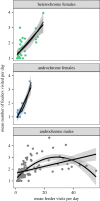Intersexual social dominance mimicry drives female hummingbird polymorphism
- PMID: 36069013
- PMCID: PMC9449474
- DOI: 10.1098/rspb.2022.0332
Intersexual social dominance mimicry drives female hummingbird polymorphism
Abstract
Female-limited polymorphisms, where females have multiple forms but males have only one, have been described in a variety of animals, yet are difficult to explain because selection typically is expected to decrease rather than maintain diversity. In the white-necked jacobin (Florisuga mellivora), all males and approximately 20% of females express an ornamented plumage type (androchromic), while other females are non-ornamented (heterochromic). Androchrome females benefit from reduced social harassment, but it remains unclear why both morphs persist. Female morphs may represent balanced alternative behavioural strategies, but an alternative hypothesis is that androchrome females are mimicking males. Here, we test a critical prediction of these hypotheses by measuring morphological, physiological and behavioural traits that relate to resource-holding potential (RHP), or competitive ability. In all these traits, we find little difference between female types, but higher RHP in males. These results, together with previous findings in this species, indicate that androchrome females increase access to food resources through mimicry of more aggressive males. Importantly, the mimicry hypothesis provides a clear theoretical pathway for polymorphism maintenance through frequency-dependent selection. Social dominance mimicry, long suspected to operate between species, can therefore also operate within species, leading to polymorphism and perhaps similarities between sexes more generally.
Keywords: Trochilidae; female-limited polymorphism; mimicry; polymorphism; resource-holding potential; sexual dimorphism.
Conflict of interest statement
The authors declare no competing interests.
Figures



Comment in
-
Female birds disguised as males get extra food.Nature. 2022 Oct;610(7931):259-260. doi: 10.1038/d41586-022-03177-7. Nature. 2022. PMID: 36216910 No abstract available.
-
Invited commentary on 'intersexual social dominance mimicry drives female hummingbird polymorphism'.Proc Biol Sci. 2022 Nov 9;289(1986):20221700. doi: 10.1098/rspb.2022.1700. Epub 2022 Nov 9. Proc Biol Sci. 2022. PMID: 36350220 Free PMC article. No abstract available.
Similar articles
-
Male-like ornamentation in female hummingbirds results from social harassment rather than sexual selection.Curr Biol. 2021 Oct 11;31(19):4381-4387.e6. doi: 10.1016/j.cub.2021.07.043. Epub 2021 Aug 26. Curr Biol. 2021. PMID: 34450085
-
Male-like female morphs in hummingbirds: the evolution of a widespread sex-limited plumage polymorphism.Proc Biol Sci. 2021 Feb 24;288(1945):20203004. doi: 10.1098/rspb.2020.3004. Epub 2021 Feb 24. Proc Biol Sci. 2021. PMID: 33622128 Free PMC article.
-
Reproductive skew and selection on female ornamentation in social species.Nature. 2009 Dec 10;462(7274):786-9. doi: 10.1038/nature08614. Nature. 2009. PMID: 20010686
-
The evolution, maintenance and adaptive function of genetic colour polymorphism in birds.Biol Rev Camb Philos Soc. 2004 Nov;79(4):815-48. doi: 10.1017/s1464793104006487. Biol Rev Camb Philos Soc. 2004. PMID: 15682872 Review.
-
Female competition and its evolutionary consequences in mammals.Biol Rev Camb Philos Soc. 2011 May;86(2):341-66. doi: 10.1111/j.1469-185X.2010.00149.x. Biol Rev Camb Philos Soc. 2011. PMID: 20636474 Review.
Cited by
-
Invited commentary on 'intersexual social dominance mimicry drives female hummingbird polymorphism'.Proc Biol Sci. 2022 Nov 9;289(1986):20221700. doi: 10.1098/rspb.2022.1700. Epub 2022 Nov 9. Proc Biol Sci. 2022. PMID: 36350220 Free PMC article. No abstract available.
-
Female birds disguised as males get extra food.Nature. 2022 Oct;610(7931):259-260. doi: 10.1038/d41586-022-03177-7. Nature. 2022. PMID: 36216910 No abstract available.
-
Evolution: A kit for fooling your rivals.Curr Biol. 2024 Oct 21;34(20):R921-R923. doi: 10.1016/j.cub.2024.09.024. Curr Biol. 2024. PMID: 39437728
-
The genomics and evolution of inter-sexual mimicry and female-limited polymorphisms in damselflies.Nat Ecol Evol. 2024 Jan;8(1):83-97. doi: 10.1038/s41559-023-02243-1. Epub 2023 Nov 6. Nat Ecol Evol. 2024. PMID: 37932383 Free PMC article.
-
The evolution of sexually dimorphic traits in ecological gradients: an interplay between natural and sexual selection in hummingbirds.Proc Biol Sci. 2022 Dec 21;289(1989):20221783. doi: 10.1098/rspb.2022.1783. Epub 2022 Dec 14. Proc Biol Sci. 2022. PMID: 36515116 Free PMC article.
References
-
- Hedrick PW, Ginevan ME, Ewing EP. 1976. Genetic polymorphism in heterogeneous environments. Annu. Rev. Ecol. Syst. 7, 1-32. (10.1146/annurev.es.07.110176.000245) - DOI
-
- Levene H. 1953. Genetic equilibrium when more than one ecological niche is available. Am. Nat. 87, 331-333. (10.1086/281792) - DOI
-
- Wallace AR. 1865. I. On the phenomena of variation and geographical distribution as illustrated by the Papilionidæ of the Malayan Region. Trans. Linn. Soc. Lond. 1, 1-71. (10.1111/j.1096-3642.1865.tb00178.x) - DOI
Publication types
MeSH terms
LinkOut - more resources
Full Text Sources

